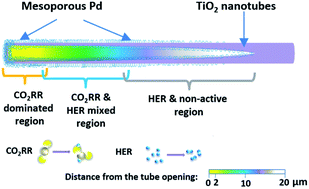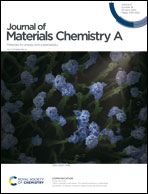Hierarchical architectures of mesoporous Pd on highly ordered TiO2 nanotube arrays for electrochemical CO2 reduction†
Abstract
The understanding of the influence of hierarchically nanostructured architectures as support materials for catalysts loading, is critical towards development of efficient electrocatalytic interfaces. The knowledge on mass transport limitation of reactants within such catalyst-support structures remains elusive. Herein, we performed systematic investigation through a novel hierarchical 1D–3D structure by loading mesoporous Pd with an average pore size of ∼10 nm and wall thickness of ∼4 nm onto highly ordered TiO2 nanotube arrays via pulse electrodeposition. Electrochemical CO2 reductions achieved a CO2-to-formate faradaic conversion efficiency of 88 ± 2% under optimal conditions. Importantly, the product selectivity is found to depend significantly on the tube length, highlighting the influence of mass transport limitations of CO2. This work offers vital insight into practical consideration in designing efficient catalyst-support interfaces with an optimal hierarchically geometry, that must optimise mass transport as well as electrochemical kinetics.



 Please wait while we load your content...
Please wait while we load your content...